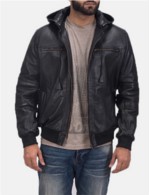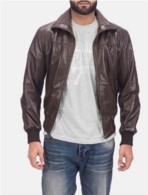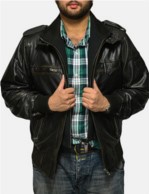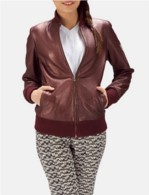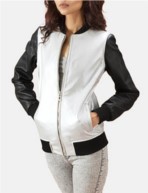When a leather bomber jacket is mentioned, everybody seems to know what sort of a jacket it is.
That is to say, they think that they know what the jacket is but there is a huge range of bomber jackets out there in the world. They can all be loosely described as being a short men’s (and ladies as well now) jacket made of leather, having a zipper in front, knitted cuffs, a ribbed trim and being gathered into a band at the waist. That is one “official” definition.
Forgetting the military designation which at times seem to overlap quite
a lot, there is a huge range of variations that are manufactured for
the “fashion” industry.
Everywhere you look you can see comments
like “strictly limited edition”. There are brand-named leather bomber
jackets everywhere.
Most of these jackets are interpretations of the original designs that were used initially by World War 2 aircrew. The main reason for having a leather jacket was to ward off the extreme cold that was encountered at high (up to 25,000 feet above sea level) altitudes where the “modern” WW2 fighters and bombers flew. The jackets were made from leather as the main requirement at those heights was the need to be warm.
But there were also a few other requirements that the jacket had to meet. The crews also needed a jacket which would not interfere with their controls or the operation of the aircraft. This was the reason for the ribbed cuffs – to ensure that there were no loose sleeves that could catch on anything. The length of the jacket was also to ensure that it would not impede the wearer in any way. If you had to get out of your aircraft in a hurry, you did not want to be impeded by a long coat tail that could get caught on something or that you could trip over. Small details like that could easily cause injuries or even kill the wearer. These factors may not seem important today, but they were then.
What other features are there of the bomber jacket that makes its original design unique?
The padded collar, although not unique to flight jackets, provides warmth around the neck area. The closed and padded cuffs also help to keep in body warmth and stop cold air from entering and moving up the arms. (Think how cold an open-sleeved jacket can get at times.)
The heavy-duty zip at the front meant that it was quick and easy to undo the jacket. Zips can sometimes be hard to get started when trying to close the jacket, but the important thing here was to be able to remove the jacket quickly.
Some jackets had an interior pocket. This was useful to keep small items in that could still be reached while sitting down in the aircraft in flight. The problem of putting such items in trouser pockets were that they were harder to get at. There was also the danger that when trying to remove one item from trouser pockets that other items could fall out and foul the equipment controls. Even today some light aircraft crashes have been caused by that happening.
A further development on some other jacket styles was the provision of an external pocket (or two) on the upper sleeve to be used for pencil or pen storage. Certainly something to write with is almost a requirement for a pilot flying smaller or older types of aircraft.
The main thing to remember when considering which leather bomber jacket to buy is what you intend using it for. The jackets which come complete with “fashion” labels are not made from the same grade of materials as the original bomber jackets or heavy-duty safety jackets such as motor-bike leathers. However, when looked after and used for the purpose for which they have been made, they will last just as long.


